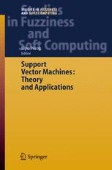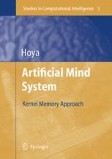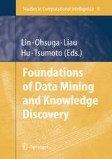Search
Search Results
-
Clustering with Intelligent Techniques
Cluster analysis is a technique for grou** data and finding structures in data. The most common application of clustering methods is to partition a...
-
New Trends of Develo** Hybrid Intelligent Systems – AIS Hybridization and DNA-Hybridization
As already mentioned in Chap.1, the use of biologically inspired CI techniques play a crucial role for the hybridisation at any level of HIS features...
-
Componentwise Least Squares Support Vector Machines
This chapter describes componentwise Least Squares Support Vector Machines (LS-SVMs) for the estimation of additive models consisting of a sum of...
-
Support Vector Machines for Signal Processing
This chapter deals with the use of the support vector machine (SVM) algorithm as a possible design method in the signal processing applications. It...
-
Theoretical and Practical Model Selection Methods for Support Vector Classifiers
In this chapter, we revise several methods for SVM model selection, deriving from different approaches: some of them build on practical lines of...
-
Adaptive Discriminant and Quasiconformal Kernel Nearest Neighbor Classification
Nearest neighbor classification assumes locally constant class conditional probabilities. This assumption becomes invalid in high dimensions due to...
-
The Artificial Mind System (AMS), Modules, and Their Interactions
The previous two chapters have been devoted to establishing the novel artificial neural network concept, namely the kernel memory concept, for the...
-
Genetic Algorithms and Genetic Linkage
This chapter provides a summary of fundamental materials on genetic algorithms. It presents definitions of genetic algorithm terms and briefly...
-
Incremental Mining on Association Rules
The discovery of association rules has been known to be useful in selective marketing, decision analysis, and business management. An important...
-
Fuzzy Support Vector Machines with Automatic Membership Setting
Support vector machines like other classification approaches aim to learn the decision surface from the input points for classification problems or...
-
Epilogue – Towards Develo** A Realistic Sense of Artificial Intelligence
So far, we have considered how the artificial mind system based upon the holistic model as depicted in Fig. 5.1 (on page 84) works in terms of the...
-
Memory Modules and the Innate Structure
As the philosopher Miguel de Umamuno (1864-1936) once said, “We live in memory and memory, and our spiritual life is at bottom simply the effort of...
-
Genetic Linkage Learning Techniques
The importance of learning genetic linkage has been discussed in the previous chapter and recognized in the field of genetic and evolutionary...
-
A Feature/Attribute Theory for Association Mining and Constructing the Complete Feature Set
A correct selection of features (attributes) is vital in data mining. For this aim, the complete set of features is constructed. Here are some...
-
Web Mining – Concepts, Applications and Research Directions
From its very beginning, the potential of extracting valuable knowledge from the Web has been quite evident. Web mining, i.e. the application of data...
-
Mining Association Rules from Tabular Data Guided by Maximal Frequent Itemsets
We propose the use of maximal frequent itemsets (MFIs) to derive association rules from tabular datasets. We first present an efficient method to...
-
CONCLUDING REMARKS
The choice of problems presented in this study is intended to emphasize that in some cases even the classical problems of acoustics can be addressed...
-
Fuzzy Subgroups of Abelian Groups
Some of the best examples of algebraic structure theory come from commutative group theory. Commutative group theory is also a principal reason for...
-
A Dynamic Model of Gene Regulatory Networks Based on Inertia Principle
In molecular biology, functions are produced by a set of macromolecules that interact at different levels. Genes and their products, proteins,...
-
A Comparative Investigation on Model Selection in Binary Factor Analysis
Binary factor analysis has been widely used in data analysis with various applications. Most studies assume a known hidden factors number k or...
